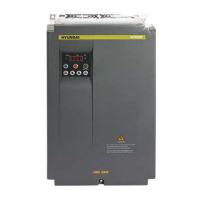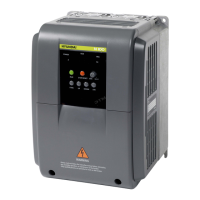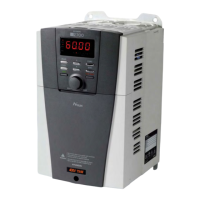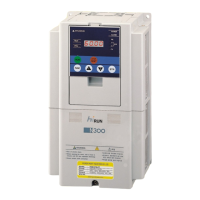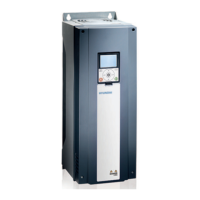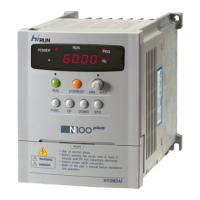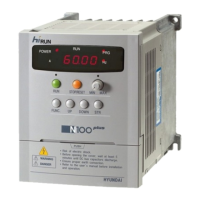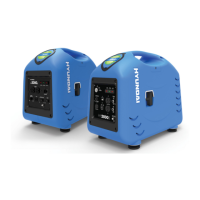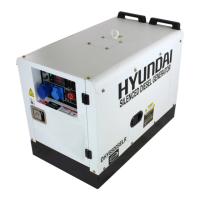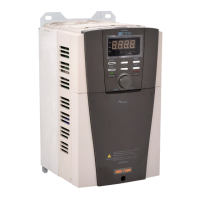
Do you have a question about the Hyundai N700 Series and is the answer not in the manual?
UL file number and web site for listing confirmation.
Warning against wiring or signal checks while power is on.
Caution against touching internal components when power is on.
Information on bus capacitor discharge time and residual voltage checks.
Details on the inverter's short circuit rating and protection.
Note that the inverter does not provide over speed protection.
Information on motor overload protection level and adjustment.
Note that motor overtemperature sensing is not provided.
Specifications for ambient temperature, humidity, storage, vibration, altitude, ambiance.
Explains hazard alert symbols, signal words (WARNING, CAUTION, NOTE).
Precautions regarding hazardous high voltage and safe servicing.
Precautions for installing the unit on appropriate surfaces and in suitable environments.
Warning that only qualified personnel should perform installation and servicing.
User responsibility for driven machinery and process line capability.
Warning for installing an earth leakage breaker for protection.
Caution regarding heavy objects and proper lifting techniques.
Caution to read and understand instructions before working on equipment.
User is responsible for grounds, disconnecting devices, and other safety devices.
Caution to connect motor thermal switch or overload devices.
Warning that rotating shafts and electrical potentials can be hazardous.
Safety warnings and cautions related to wiring the unit.
Safety precautions during control and operation of the inverter.
Safety guidelines for maintenance, inspection, and part replacement.
Additional safety notes for general handling and modification.
Checklist for safety and compliance with EMC directive.
Requirements for power supply to the inverter for EMC compliance.
Installation measures for EMC compliance, including using specific filters.
Wiring guidelines to satisfy EMC requirements.
Environmental guidelines for compliance when using filters.
Requirements for protective enclosures (cabinets/covers) to conform to LVD.
Instructions for wiring practice and specification of copper conductors.
Table detailing tightening torque, wire range, and terminal size for field wiring.
Table listing fuse sizes and manufacturers for different inverter models.
Explains hazard alert symbols, signal words (DANGER, CAUTION, NOTE).
Precautions for installing the unit on appropriate surfaces and in suitable environments.
Safety warnings and cautions related to wiring the unit.
Safety precautions during control and operation of the inverter.
Safety guidelines for maintenance, inspection, and part replacement.
Additional safety notes for general handling and modification.
Instructions for inspecting the unit after unpacking.
Information about the purpose and use of the instruction manual.
Information for inquiries and details on the warranty period and conditions.
Visual overview of N700E-055LF/075LFP to N700E-220HF/300HFP.
Visual overview of N700E-300HF/370HFP to N700E-1320HF/1600HFP.
Visual overview of N700E-1600HF/2000HFP to N700E-2200HF/2500HFP.
Visual overview of N700E-2800HF/3200HFP to N700E-3500HF/3800HFP.
Safety precautions for installing the inverter in various environments.
Guidelines for handling and mounting the inverter safely.
Specifications for ambient temperature and humidity.
Requirements for air quality and ventilation in the installation environment.
Guidance on inverter mounting orientation and enclosure ventilation.
Method for installing the inverter with heatsink outside the enclosure.
Safety warnings before performing wiring work.
Safety cautions related to input voltage, output terminals, and DC terminals.
Diagram illustrating main and control circuit terminal connections.
Explanation of symbols and functions for main circuit terminals.
Explanation of signals and functions for control circuit terminals.
Explanation of intelligent and alarm output terminals.
Safety warnings before and during main circuit wiring.
Instructions for connecting main power terminals (R, S, T).
Instructions for connecting inverter output terminals (U, V, W).
Instructions for connecting DC reactor terminals (PD, P).
Instructions for connecting external braking resistor terminals (P, RB).
Instructions for connecting regenerative braking unit terminals (P, N).
Instructions for proper grounding of the inverter and motor.
Diagrams showing main circuit terminal wiring for different inverter models.
Diagrams showing main circuit terminal wiring for larger inverter models.
Lists applicable tools and optional accessories for improved performance.
Table of common tools for heavy-duty N700E inverters.
Table of common tools for normal-duty N700E inverters.
Diagram for control circuit terminal connections.
Diagrams showing connections to programmable logic controllers.
Explanation of the RS-485 terminating resistor function.
Safety warnings for operating the inverter.
Safety cautions related to inverter operation, speed, and braking.
Describes different methods for operation setting and frequency setting.
Method of controlling operation and frequency via terminal control.
Method of controlling operation and frequency via digital operator.
Method of controlling operation and frequency using both methods.
Procedure for performing a test run using terminal control.
Procedure for performing a test run using the digital operator.
Overview and parts identification of the standard-type digital operator.
Detailed description of the keys on the digital operator.
Map for navigating through extended function modes.
Explanation of display indicators based on settings.
Explanation of the SHIFT function for digit movement and data setting.
List and description of monitor mode functions (d-group).
List and description of trip and warning monitor functions.
Description of basic function parameters like frequency and time settings.
Parameters related to frequency command and run command settings.
Parameters for multi-speed settings and V/F characteristics.
Parameters for DC injection braking settings.
Parameters for frequency upper/lower limits and jump settings.
Parameters for Automatic Voltage Regulation and second stage accel/decel.
Parameters for acceleration/deceleration curves and analog input settings.
Parameters for PID control functions.
Parameters for PID output limits and gain adjustments.
Parameters for restart modes and electronic thermal overload alarm.
Parameters for overload restriction and software lock mode.
Parameters for start frequency, carrier frequency, initialization, and speed search.
Parameters for voltage/speed increase/decrease, frequency match, failure output, inverter type.
Parameters for communication settings and braking resistor selection.
Settings for intelligent input terminals 1 through 6.
Settings for input terminal status and intelligent output terminals.
Settings for FM output, gain/offset, and overload advance notice.
Settings for AMI output and acceleration/deceleration arrival signals.
Parameters for auto-tuning mode, motor data selection, and capacity.
List and description of intelligent input terminals.
Description of terminals for frequency commanding and monitoring.
Description of intelligent output terminals and alarm output terminals.
Explanation of the FM terminal for analog output monitoring.
Explanation of the AMI terminal for analog output monitoring.
Functionality of FW and RV terminals for forward and reverse operation.
How to use CF terminals for selecting multiple speeds.
Mapping set codes to control terminals for multi-speed selection.
Steps for programming multi-speed settings using CF switches or parameters.
How to use the JG terminal for jogging operation.
How to use RS-485 communication for jogging.
How the 2CH terminal affects acceleration and deceleration times.
Functionality of the FRS terminal for stopping the motor.
How the EXT terminal triggers a trip state.
Function of the USP terminal to prevent automatic startup.
How the SFT terminal locks parameters from editing.
How the AT terminal selects voltage or current input for frequency control.
How the RS terminal resets the inverter and clears trip states.
How STA, STP, and F/R terminals control start, stop, and direction.
How UP and DOWN terminals change output frequency.
Selecting between local keypad or terminal input operation.
How the PIDIR terminal resets the PID controller's integral term.
How the PIDD terminal disables or enables PID control.
How the RUN signal indicates inverter operation status.
FA1/FA2 signals indicate when output frequency reaches a setpoint.
OL signal indicates when output current exceeds a preset threshold.
OD signal indicates when PID loop error exceeds a threshold.
AL signal indicates when an alarm or fault has occurred.
Description and operation of alarm output terminals AL0, AL1, AL2.
Overview of sensorless vector control capabilities.
Steps for setting up sensorless vector control.
How auto-tuning automatically sets motor parameters.
Step-by-step guide for performing auto-tuning.
Flowchart illustrating the auto-tuning process.
Parameters for digital panel setup of auto-tuning and motor data.
Adjustments for observed symptoms if auto-tuning performance is not optimal.
Table listing inverter protective functions, causes, and error codes.
Displays for initialization status and auto-tuning results.
Causes and countermeasures when the motor does not move.
Causes and countermeasures for reversed motor direction.
Causes and countermeasures when motor speed is low.
Causes and countermeasures for unstable motor rotation.
Causes and countermeasures when RPM doesn't match output frequency.
Causes and countermeasures for incorrect inverter data.
Causes and countermeasures when parameters don't change or revert.
Precautions during data setting and storage.
General safety messages before maintenance and inspection.
Details on daily, periodic, and insulation resistance tests.
List of recommended spare parts like cooling fans and cases.
Chart for overall, main circuit, and control circuit inspections.
How to measure key system electrical parameters.
Settings for communication number, speed, and data bits.
Description of the RJ-45 connector and pin assignments.
Explanation of the communication sequence between controller and inverter.
Structure of external controller and inverter communication frames.
Details of transmit and response frame structures.
Step-by-step process for generating 16-bit CRC.
Technical specifications for 200V class inverters.
Technical specifications for 400V class inverters.
General specifications applicable to all models.
Guidance on selecting braking resistors and breaking units.
External dimensions for smaller N700E models.
External dimensions for mid-range N700E models.
External dimensions for larger N700E models.
External dimensions for very large N700E models.
Comprehensive table of dimensions and weights for all models.
List of revisions made to the manual over time.
